Painting, photography, drawing, sculpture
Participating artists: Sean Dunstan-Halliday, Amanda E. Gross, Rachel Hammerman, Kati Mennett, Bryan Ramey, and Katharena Rentumis
Arsenal Center for the Arts
Watertown, MA
January 10 – February 8, 2013
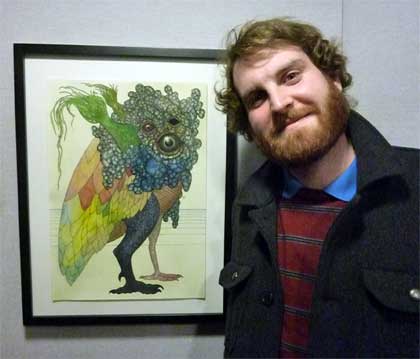
Photo: C. Munitz
Courtesy of the artist
and Arsenal Center for the Arts
It was a delight to get to see this exhibition a couple of times during its recent run. I had seen the 30 Under 30 show this fall, but because each of the thirty artists in that show only had a single piece, it was difficult to get a diversified sense of the work of each of them. This time, each of the six selected artists from that larger group was able to include a number of works, making that multi-perspectival sense possible.
Given an opportunity to see Sean Dunstan-Halliday’s work on an earlier occasion, I had been impressed by the precision, inventiveness and penetrating quality of his paintings. In some of the earlier works I had seen, particularly in what he calls the Portraits – of birds of various sorts – there was a conveyance of demonstrable intensity complementing a richly detailed representation. The interplay of the exquisite care in the articulation of the outward features of these creatures and the pictorial conjuring of focused energy in the gazes that roar out from those details is striking.
In the current exhibition, Dunstan-Halliday’s work continues upon the same theme, but utilizes a greater experimentation with morphing and combining animal and plant forms. Having seen Dunstan-Halliday’s earlier portraits made me wonder about the inner nature of these strange and interesting newer hybrids, and how those penetrating gazes – so evocative in those earlier pieces – might have evolved. In some cases, new eyeless hybrids show no apparent gaze; one is left to one’s own devices to imagine it. In other cases, the gaze appears within a symphony of mutations, trying to express a coherent self from a body which has developed according to the evolutionary jazz Dunstan-Halliday has inspired it to play.
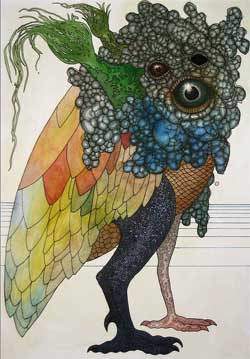
14 1/8″ x 20″
Watercolor and pen on paper
Courtesy of the artist
and Arsenal Center for the Arts
(Above) An aggregate of feathers and unspecified protoplasm hovers on two different legs, one avian and another a bit more reptilian. A pair of eyes look out, one of them merely a socket, the other brown and probing. In the place of a mouth or nose, another large eye appears, spurring us to ask what inhabits this creature, what creates its gaze? Given its outward complexity, its gaze is remarkably affecting. Two seaweed like fronds erupt from its side, suggesting this is part plant as well, phtotosynthesizing as well as flying. From this symphony of disparate forms, somehow a poignantly coherent creature emerges.
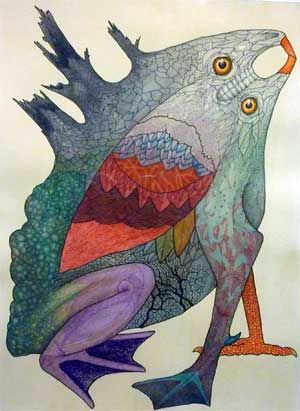
Photo: C. Munitz
Courtesy of the artist
and Arsenal Center for the Arts
(Above) A planarian creature with a curious beak of converging orange protuberances squats on webbed feet, while another nailed birdlike foot thrusts out behind. A network of black capillaries runs through its abdomen just below a variegated and cavernous expanse deep with reds of varying textures. Is that surface or depth emerging within? Perhaps it is a little of both, suggesting that, for complex creatures of this sort, inside and outside may be reversible, varied, and topologically complex surfaces of the self.
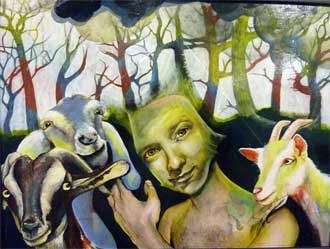
Photo: C. Munitz
Courtesy Arsenal Center for the Arts
Paintings by Amanda E. Gross include a series of vivid portraits with penetrating faces embellished by entertaining adornments and enhanced by suggestions of dimensional variation.
In Luke, a goat-like man is surrounded by several goats. The background trees lift off the earth like horns. Luke’s head is part human, part wisp, part landscape, a cosmic, but emotionally accessible, satyr. In this nicely constructed group portrait, Luke and two of his goats look at us, while the goat on the right looks at him, encouraging our eyes to enter into a dynamic flow within and without the spatial forest of the painting.
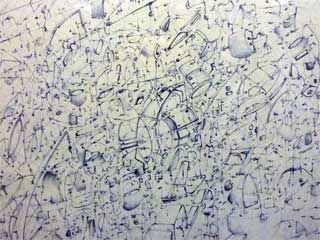
“Where oceans poised on diving boards plunge
Like belly floppers
Slapping waters
Along long battlefields of sand”
Ink on paper, 9″ x 12″
Photo: C. Munitz
Courtesy Arsenal Center for the Arts
Rachel Hammerman’s ink drawings are aggregate suggestions of multifaceted activity, with incipient forms emerging everywhere, seeming to have great relationship and interacting like a huge Rube Goldberg network, but one step away from clarity and explicit representation. These complex almost-worlds are highly suggestive, great hides and seeks that draw one in, making one want to keep looking, searching.
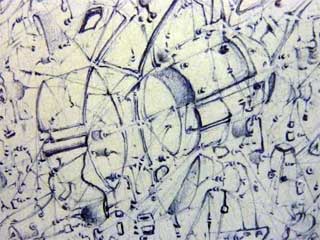
Detail from “Where oceans poised on diving boards…”
Photo: C. Munitz
Courtesy Arsenal Center for the Arts
Each of these pieces has a several line poem for its title, a little unwieldy, but a really nice idea.
One of these drawings is called: Make black holes melt inside the swollen pulse of possibility – a beautifully expressed inspiration for an image.
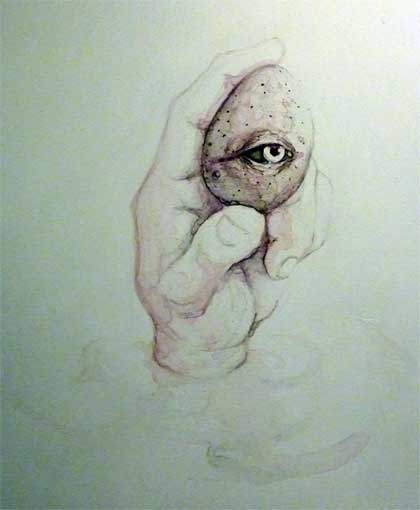
Photo: C. Munitz
Courtesy Arsenal Center for the Arts
Bryan Ramey’s works exhibit witty and evocative characterizations of emotions and mental states.
In Foresight, a small rock or egg with a perspicacious eye looking out is held gingerly between a thumb and a forefinger. The striking gaze from that single eye invites the viewer to look back; caught in the seduction of that gaze, one can draw back only intermittently to digest its coyly suggestive visual metaphor.
– BADMan
Leave a Reply